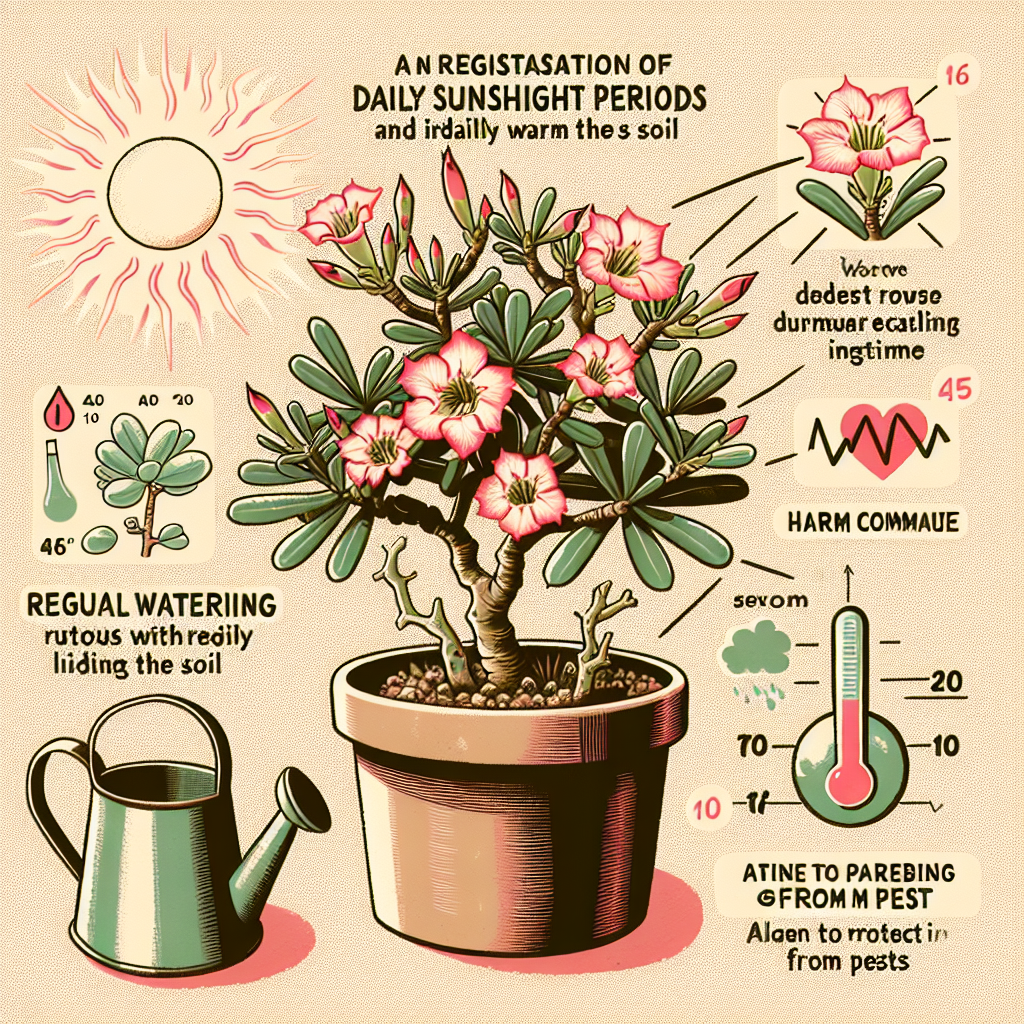
How to care for adenium obesum desert rose
How to Care for Adenium Obesum (Desert Rose): A Complete Guide
The Adenium obesum, commonly known as the Desert Rose, is a stunning succulent that is cherished for its beautiful, trumpet-shaped flowers and unique, thick trunk. Its ability to thrive in arid conditions makes it a popular choice among gardeners, especially those looking for low-maintenance, drought-tolerant plants. In this article, we will explore everything you need to know about how to care for Adenium obesum, ensuring that your plant thrives and provides a stunning display year after year.
Understanding the Desert Rose
Before diving into care tips, it's essential to understand the plant itself. The Adenium obesum is native to the arid regions of Africa and the Arabian Peninsula. It grows in a variety of colors, with the most common being shades of pink and red. The plant is a member of the Apocynaceae family and can grow up to 4 feet tall in optimal conditions.
Ideal Growing Conditions
The first step in caring for your Desert Rose is to ensure it has the right growing conditions. Here are the key factors to consider:
- Light: Adenium obesum thrives in bright light. Position your plant near a south-facing window or in a location that receives at least 6 hours of direct sunlight daily.
- Temperature: This plant enjoys warm temperatures, ideally between 65°F to 95°F (18°C to 35°C). It's intolerant to frost, so bring it indoors during colder months.
- Humidity: Low humidity is preferred. This makes it suitable for most indoor environments, providing adequate air circulation.
Soil Requirements
Proper soil is crucial for the health of your Adenium obesum. Here’s what to keep in mind:
- Drainage: Excellent drainage is paramount. A sandy, well-draining potting mix works well. You can use a cactus or succulent mix or create your own blend.
- pH Level: The ideal pH level for Desert Roses is between 6.0 and 7.0. Regularly check the pH of your soil to ensure it's within this range.
Watering Your Desert Rose
Watering is one of the most critical aspects of caring for Adenium obesum. Here are some guidelines:
- Frequency: Water the plant deeply, then allow the soil to dry out completely before watering again. This usually translates to once every 1-3 weeks, depending on the climate.
- Seasonal Adjustments: During the growing season (spring and summer), increase watering slightly. In the dormant period (fall and winter), reduce watering significantly.
- Signs of Overwatering: Yellowing leaves and a mushy trunk indicate overwatering, so always check the soil moisture before watering.
Fertilizing Adenium Obesum
Fertilizing your Desert Rose appropriately will promote vibrant flowers and healthy growth. Here’s how to do it:
- Type of Fertilizer: Use a balanced, water-soluble fertilizer with a ratio like 10-10-10 or one formulated for succulents.
- Frequency: Feed the plant every 4-6 weeks during the growing season (spring and summer). Do not fertilize during dormancy in the fall and winter.
Repotting Your Plants
Repotting is essential to give your Desert Rose room to grow. Here’s how and when to repot:
- When to Repot: Generally, repot every 2-3 years or when you notice roots growing out of the drainage holes.
- How to Repot: Choose a pot that’s one size larger and fill it with fresh, well-draining soil. Carefully remove the plant, taking care not to damage the roots, and place it in the new pot, filling in with soil without burying the trunk.
Pests and Diseases
While Adenium obesum is relatively pest-resistant, it's not entirely immune. Here are some common pests and how to handle them:
- Aphids: These small green pests suck sap from the plant. You can remove them by spraying the plant with water or using insecticidal soap.
- Mealybugs: They appear as white cottony masses. Treat them with neem oil or simply wipe them off with a cotton swab dipped in alcohol.
- Root Rot: This often occurs due to overwatering. Ensure proper watering practices and use well-draining soil to prevent this issue.
Blooming and Pruning
The flowering of the Desert Rose can be a breathtaking spectacle, and proper care aids in boosting blooms. Here’s how to encourage blooming:
- Light Exposure: Ensure the plant receives adequate sunlight for optimal blooming.
- Temperature: Maintain warm temperatures to promote flowering.
- Pruning: Prune after flowering to maintain shape and remove dead or damaged branches. This stimulation encourages new growth and blooms.
Winter Care for Adenium Obesum
Winter can be challenging for the Desert Rose, especially in cooler climates. Here are some winter care tips:
- Temperature Control: Keep the plant indoors if temperatures drop below 50°F (10°C). Ensure it's in a warm spot with adequate light.
- Watering Routine: Cut back on watering significantly. Allow the plant to go dormant, reducing water to prevent root rot.
- Monitor for Pests: Indoor plants can still attract pests, so check regularly and take action as needed.
Conclusion
Caring for your Adenium obesum (Desert Rose) can be a rewarding experience. With its striking appearance and resilience, this succulent not only enhances your garden or indoor space but also provides an opportunity for engaging horticultural practices. By understanding its growing conditions, soil requirements, watering regimen, and seasonal care, you can create an environment conducive to vibrant blooms and healthy growth.
Whether you're a seasoned gardener or a beginner, following these guidelines will help you nurture your Desert Rose into a robust and beautiful addition to your plant collection. Keep experimenting with its care, observe its reactions, and soon you'll become an expert at keeping this captivating species thriving!
By Guest, Published on October 2nd, 2024